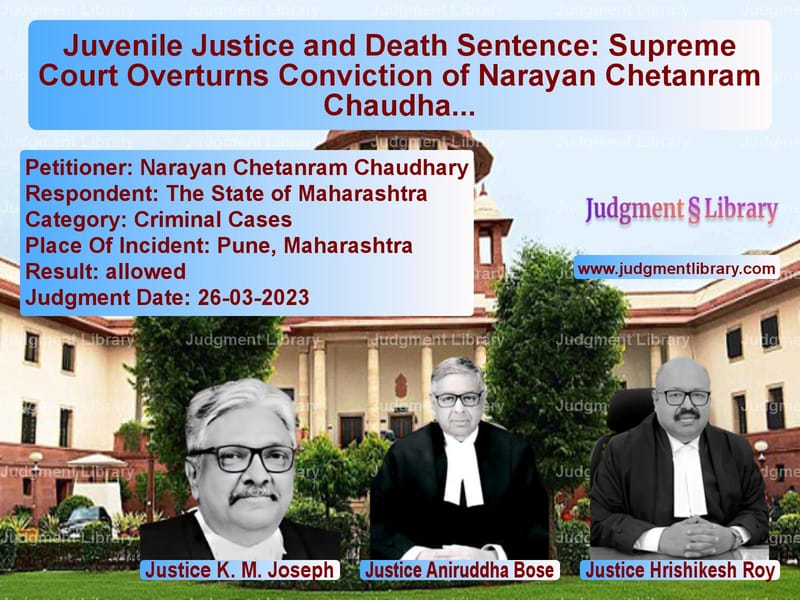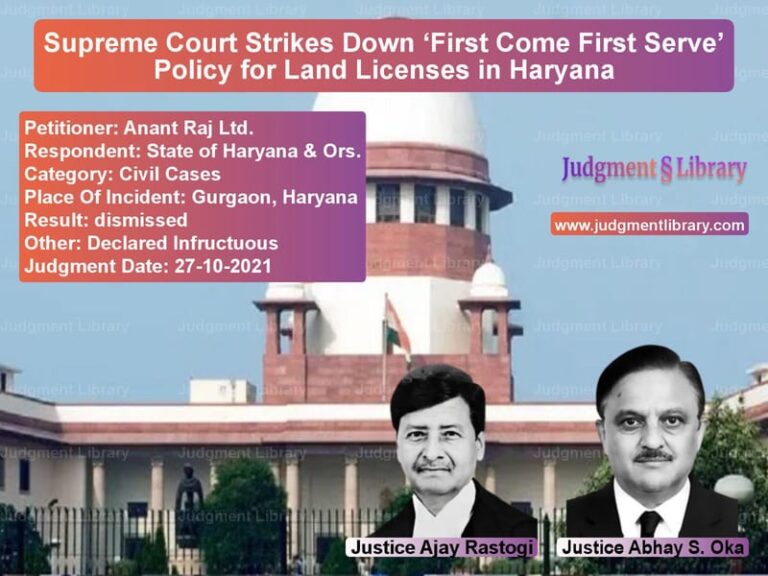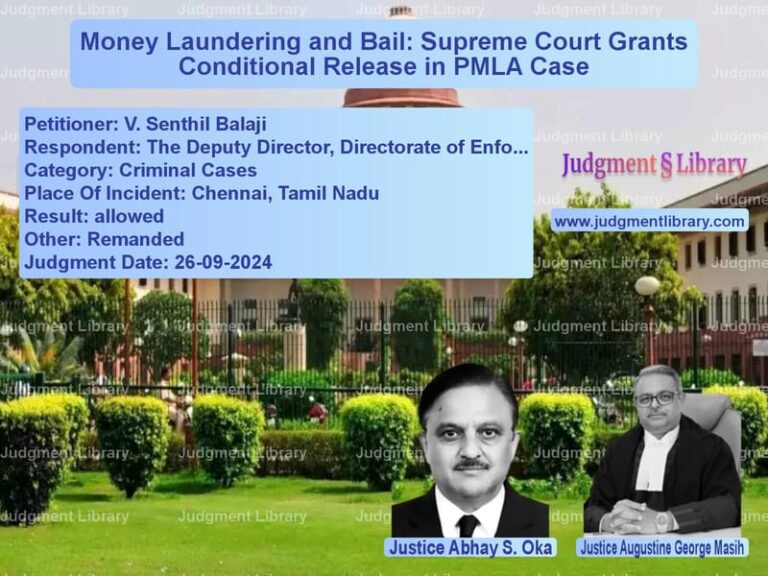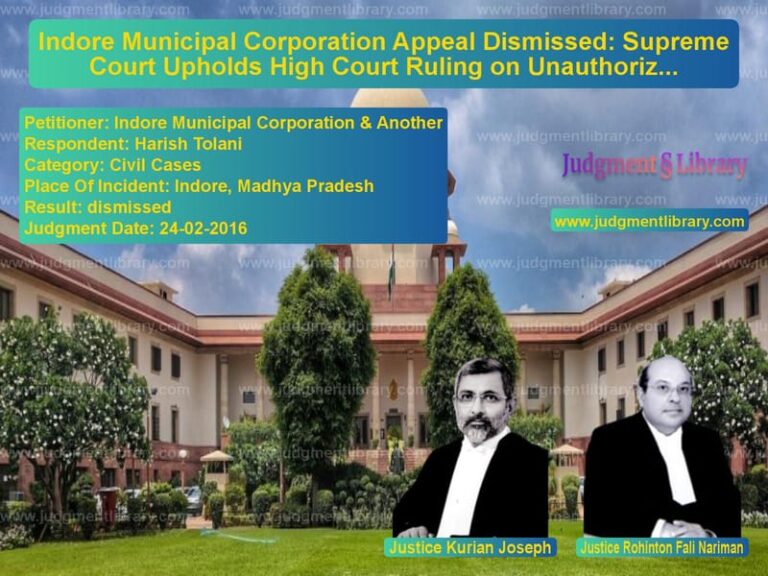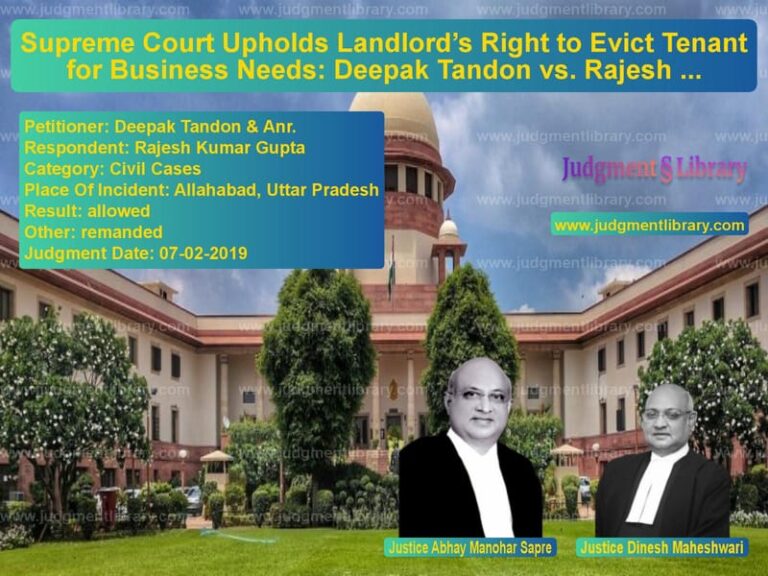Juvenile Justice and Death Sentence: Supreme Court Overturns Conviction of Narayan Chetanram Chaudhary
The Supreme Court of India recently delivered a significant ruling in the case of Narayan Chetanram Chaudhary v. State of Maharashtra, addressing the issue of juvenility in a death sentence case. The case involved the question of whether the petitioner was a juvenile at the time of the crime and whether his death sentence should be set aside based on the provisions of the Juvenile Justice (Care and Protection of Children) Act, 2015. The Court ruled in favor of the petitioner, setting aside his conviction and ordering his immediate release.
Background of the Case
The case involved a brutal multiple murder incident that took place on August 26, 1994. The accused, Narayan Chetanram Chaudhary, was arrested on September 5, 1994, and subsequently convicted for the offense. He was sentenced to death, a punishment that was upheld through various appellate stages, including the High Court and Supreme Court.
In 2022, the petitioner raised a fresh claim that he was a juvenile at the time of the offense and, therefore, could not have been sentenced to death. He relied on school records that allegedly proved he was under 18 years old on the date of the incident.
Read also: https://judgmentlibrary.com/supreme-court-upholds-default-bail-for-kapil-wadhawan-in-pmla-case/
Legal Issues Considered
- Whether the petitioner was a juvenile under the Juvenile Justice (Care and Protection of Children) Act, 2015 at the time of the offense.
- Whether a claim of juvenility could be raised at such a late stage, after the conviction had been upheld through multiple appeals.
- Whether the evidence provided by the petitioner, including school records, was sufficient to establish his age.
- Whether the death sentence could stand in light of the petitioner’s juvenility claim.
Arguments of the Parties
Petitioner’s Arguments
- The petitioner, represented by senior advocate R. Basant, argued that his real name was Niranaram and that his date of birth, as per school records, was February 1, 1982, making him a juvenile (under 18 years old) on the date of the crime.
- He contended that the school records were issued by a government institution and should be accepted as conclusive proof of his date of birth.
- He relied on the provisions of Section 9(2) of the Juvenile Justice Act, which allows juvenility claims to be raised at any stage, even after conviction.
- He argued that since the law prohibits the death penalty or life imprisonment for juveniles, his conviction and sentence should be set aside.
Respondent’s Arguments
- The State of Maharashtra, represented by Sachin Patil and Hrishikesh Chitaley, argued that the petitioner had never raised the issue of juvenility during the trial, appeal, or review proceedings.
- The prosecution contended that the school records were fabricated and that the petitioner’s identity as “Narayan” was different from the name mentioned in the school documents.
- They relied on a forensic age determination conducted in 2005, which estimated the petitioner’s age to be between 22 to 40 years, indicating that he was an adult at the time of the offense.
- They argued that allowing such claims at a late stage would open the floodgates for convicted criminals to escape punishment by producing fabricated documents.
Key Observations of the Supreme Court
The Supreme Court, after a thorough examination of the evidence, made several important observations:
- School Records as Evidence: The Court noted that the school admission register and certificates were issued by a government school and indicated the petitioner’s date of birth as February 1, 1982. These records were accepted as credible evidence.
- Forensic Age Estimation: The Court observed that the forensic report from 2005 provided a broad age range (22-40 years), making it inconclusive. Given the lower bound of the estimate, the possibility of juvenility could not be ruled out.
- Applicability of Section 9(2) of the Juvenile Justice Act: The Court held that a claim of juvenility can be raised at any stage, including after the final conviction, as per the statutory provisions.
- Death Sentence Violates Juvenile Justice Law: The Court ruled that under the Juvenile Justice Act, no person who was a juvenile at the time of the offense can be sentenced to death or life imprisonment.
Key Judgment Excerpts
The Supreme Court, citing precedent, stated:
“Once the court finds that a person has committed an offense and was a child on the date of commission of such offense, it shall forward the child to the Board for passing appropriate orders, and the sentence, if any, passed by the court shall be deemed to have no effect.”
The Court further held:
“The statutory provisions of the Juvenile Justice Act override any previous conviction and sentence, including death penalties. The petitioner, having spent more than 28 years in custody, has already served more than the maximum permissible detention period under the Act.”
Final Judgment
Based on the findings, the Supreme Court:
- Declared the petitioner to be a juvenile at the time of the offense.
- Set aside the conviction and death sentence.
- Ordered the immediate release of the petitioner, considering that he had already served more than the legally permitted maximum period under the Juvenile Justice Act.
Implications of the Judgment
The ruling has significant implications for criminal law and juvenile justice:
- Strengthens Juvenile Rights: The judgment reinforces the legal principle that juveniles cannot be subjected to the death penalty or life imprisonment.
- Sets a Precedent for Future Cases: Courts are now required to examine age-related claims seriously, even at a late stage.
- Emphasizes Due Process: The ruling ensures that individuals are not denied justice due to procedural lapses or delayed claims.
- Protects Fundamental Rights: The judgment affirms that juveniles must be treated in accordance with child protection laws, regardless of the severity of the offense.
Conclusion
The Supreme Court’s decision in Narayan Chetanram Chaudhary v. State of Maharashtra is a landmark ruling that upholds the fundamental principles of juvenile justice. By recognizing the petitioner’s juvenility and setting aside his death sentence, the Court has reinforced the importance of treating children in conflict with the law with fairness and legality. This judgment will serve as a crucial precedent in ensuring that juveniles are not wrongfully subjected to capital punishment due to delays in asserting their legal rights.
Petitioner Name: Narayan Chetanram Chaudhary.Respondent Name: The State of Maharashtra.Judgment By: Justice K. M. Joseph, Justice Aniruddha Bose, Justice Hrishikesh Roy.Place Of Incident: Pune, Maharashtra.Judgment Date: 26-03-2023.
Don’t miss out on the full details! Download the complete judgment in PDF format below and gain valuable insights instantly!
Download Judgment: narayan-chetanram-ch-vs-the-state-of-maharas-supreme-court-of-india-judgment-dated-26-03-2023.pdf
Directly Download Judgment: Directly download this Judgment
See all petitions in Bail and Anticipatory Bail
See all petitions in Juvenile Justice
See all petitions in Judgment by K.M. Joseph
See all petitions in Judgment by Aniruddha Bose
See all petitions in Judgment by Hrishikesh Roy
See all petitions in allowed
See all petitions in supreme court of India judgments March 2023
See all petitions in 2023 judgments
See all posts in Criminal Cases Category
See all allowed petitions in Criminal Cases Category
See all Dismissed petitions in Criminal Cases Category
See all partially allowed petitions in Criminal Cases Category

